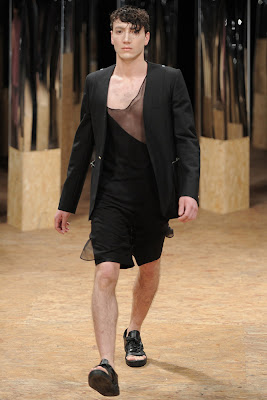I was very surprised when I noticed Sebastiaan Pieter Groenen's collection won the collection of the year in the LCF graduate show in June. It's not the catchiest collection and you might blind yourself with other collections applying loads and loads of colours and patterns (remember the winner last year is the vivid Nova Chiu!). Besides the ambiguous colours, the raw cuts is my favourite element in the collection. Those rough finishing are just like helping the garments for a dissection to be a better look. I love those sheer layering too. They gave a great balance to the cautious feeling which suit always projects. Ok! I will stop praising and let you read Sebastiaan's thought yourself.
Could you introduce yourself and tell us a bit about your background?
I grew up in the Netherlands near Amsterdam and moved to London 5 years ago to start studying fashion. First at Central Saint Martins doing a foundation degree and later at London College of Fashion studying Bespoke Tailoring.
During my summer breaks I did a lot of internships to develop a better understanding of the industry. My first internship was with a womenswear brand in New York called Tucker by Gaby Basora, she really gave me an all round perspective on how a fashion brand works.
I also had the pleasure of working with companies I really admire such as Fantastic Man, Monocle and Jil Sander, and I try to stay in touch with all of them. All these experiences helped shape my perspective on how I want to design and what kind of audience you like to attract.
How do you usually start your collections? What inspire you most?
I start from imagery that I find online or in books. I collect a lot and then make a selection of things that I think work well together. For my graduate collection I looked at geodes (stones with crystals on the inside), capsules in architecture, helmut lang archive images amongst other things. Then I also get inspired by what people are wearing in the street, how they style themselves and what they want to express with that.
What do you consider first when designing – silhouette, colours and patterns or materials?
I start with an idea/concept of what I'd like the clothes to tell. I like to question everything we wear. In a way you are a billboard of clothes as they always making a statement about who you are, what your lifestyle is etc. I find it quite intriguing to develop these story lines and the rest follows from there.
For my final collection the fabrics were already decided, I had to work with woven woollens to be able to apply bespoke tailoring techniques. But I did spend a lot of time finding the right colours and (fabric) weights that would fit my message .
Why did you apply for tailoring for your BA and how do you feel about your study life?
I chose the course because I wanted to be assured I learned a skill. A lot of my friends were disappointed with the pathways they chose as they weren't learning anything about how to construct clothes. I can now make a fully bespoke suit by hand, by myself, which I think is quite amazing (though I have to say my quality isn't as good as Savile Row yet haha).
How do you see the menswear industry in 5 years later?
Menswear mostly consists out of a group of very specific garments (the suit/jeans/t-shirt/etc), in the next 5 years I don't see much evolution there. However people are just getting started with 3-D printing and I think through this we'll see some changes in how garment are constructed. Also I think a lot more of what we communicate and how we reach out to consumers will be digital, there is so much opportunity to develop online and I don't think we've reached exciting highs here yet.
Could you tell us more about your collection? What is the biggest difficulty during the design process?
As I said before I was looking at geodes and capsules. I wanted to show these looks that had layers to them, with an opposition between outside and inside. This translated into the tailored shell, often exposing the layers within the suit where I cut into the jackets. This sat on top of a very fluid base layers of silk which gave a very soft versus hard feeling.
Biggest challenge for me was working my ideas into these very traditional suits that I had learned to make on the course. It was confusing for my tutors to see these materials that go inside the jackets exposed. Where they taught us to cover everything up and make it look perfect I was showing roughness and unfinished edges. It was then my challenge to still make this look controlled and not like a mistake.
Is there any emerging designer that you want to work with?
I greatly admire how JW Anderson has managed to establish himself so quickly and how he's challenging people's perspective on menswear. I also really admire the work of Meadham Kirschoff, I think they have an uniquely refreshing perspective on women and menswear.
As a LCF graduate, do you have any advice for other fashion students?
Very simple but, be as openminded as you can and sometimes do that thing that you are most afraid of.
What’s next!?
I'm looking do gain more experience working as a designer in luxury menswear within an established company. However I also want to continue developing my own collections and in a couple years set up my own brand.
















No comments:
Post a Comment